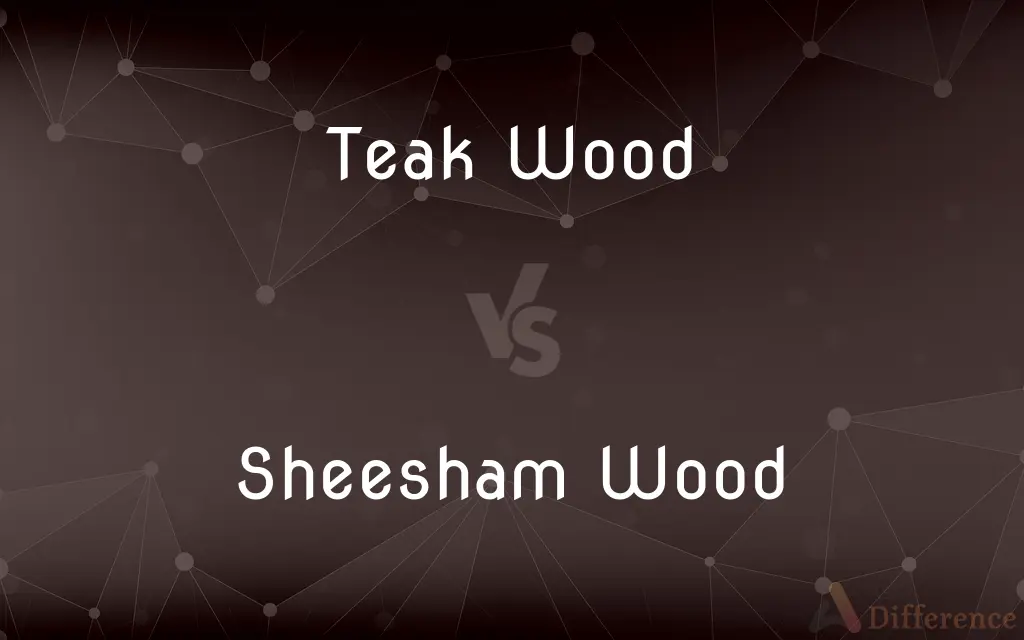Teak Wood vs. Sheesham Wood — What's the Difference?
By Tayyaba Rehman — Published on November 1, 2023
Teak Wood is a tropical hardwood known for its durability and water resistance, while Sheesham Wood, also called Indian Rosewood, is a dense, dark wood primarily from the Indian subcontinent.

Difference Between Teak Wood and Sheesham Wood
Table of Contents
ADVERTISEMENT
Key Differences
Teak Wood and Sheesham Wood are both popular choices for furniture and other woodworking projects, each offering unique attributes. Teak Wood, which hails primarily from Southeast Asia, especially Burma, Thailand, and Indonesia, is prized for its resilience and ability to resist environmental damage. Its natural oils make it especially resistant to water, insects, and decay. Conversely, Sheesham Wood, predominantly sourced from the Indian subcontinent, is also known as Dalbergia sissoo or Indian Rosewood. This wood is dense, durable, and known for its rich, deep color and striking wood grain patterns.
In terms of usage, Teak Wood is often chosen for outdoor furniture because of its high water resistance and ability to withstand diverse weather conditions. It can be found in boat decks, outdoor furniture, and high-end indoor furnishings. Sheesham Wood, with its strong and dense nature, is commonly used for cabinets, flooring, and furniture. Its beautiful grain makes it an attractive choice for decorative pieces and quality furniture.
When discussing price and availability, Teak Wood is generally more expensive due to its exceptional qualities and diminishing resources. The increased demand for teak, combined with its slower growth rate, has driven prices up. Sheesham Wood, being more abundantly available, especially in regions like India and Pakistan, tends to be more affordable. Yet, it's important to note that Sheesham Wood's quality and characteristics make it a highly sought-after wood in its own right.
From a care perspective, both Teak Wood and Sheesham Wood require proper maintenance to retain their beauty. Teak may develop a silvery-gray patina over time, especially when used outdoors, and might require occasional oiling to maintain its golden-brown hue. Sheesham Wood, meanwhile, benefits from regular dusting and cleaning to accentuate its natural sheen and prevent any potential damage from moisture or pests.
Comparison Chart
Origin
Southeast Asia
Indian subcontinent
ADVERTISEMENT
Common Usage
Outdoor furniture, boat decks
Indoor furniture, cabinets, flooring
Durability & Resistance
High resistance to water, decay, and insects
Durable and dense
Appearance
Golden-brown, may gray over time
Rich, deep color with striking grain
Cost
Generally more expensive
More affordable
Compare with Definitions
Teak Wood
A tropical hardwood known for its durability.
Teak Wood furniture can last for decades if properly maintained.
Sheesham Wood
Dense, durable wood ideal for cabinets and furniture.
The study's bookshelves, made of Sheesham Wood, were built to last.
Teak Wood
Native to countries in Southeast Asia.
Many teak plantations are found in Thailand and Indonesia.
Sheesham Wood
Generally more affordable than other hardwoods like teak.
Opting for Sheesham Wood, they could stay within their budget.
Teak Wood
Often used for quality indoor and outdoor furniture.
The elegant dining set was crafted from the finest Teak Wood.
Sheesham Wood
Recognized for its rich color and distinct grain patterns.
The intricate patterns in the Sheesham Wood table were mesmerizing.
Teak Wood
Noted for its natural water and insect resistance.
Many boat decks are made of Teak Wood because of its resilience.
Sheesham Wood
Also known as Indian Rosewood or Dalbergia sissoo.
Sheesham Wood is a favorite among furniture makers in India.
Teak Wood
Can develop a gray patina over time if left untreated.
The Teak Wood bench had a silvery sheen after years in the sun.
Sheesham Wood
Predominantly found on the Indian subcontinent.
Local artisans often use Sheesham Wood for their creations.
Common Curiosities
And Sheesham Wood?
Also called Indian Rosewood, it's a dense, dark wood primarily from India.
What is Teak Wood?
A durable tropical hardwood known for its resistance to environmental damage.
Where is Sheesham Wood primarily sourced?
From the Indian subcontinent, especially India and Pakistan.
Why is Teak Wood so expensive?
Its exceptional qualities and limited resources drive up demand and price.
How do you care for Sheesham Wood furniture?
Regular dusting and cleaning help maintain its sheen.
Does Teak Wood require maintenance?
Yes, especially outdoors, it may need oiling to maintain its color.
Can Teak Wood be used for indoor furniture?
Yes, it's often chosen for high-end indoor furnishings due to its beauty.
What's unique about Sheesham Wood's appearance?
It has a rich, deep color and striking wood grain patterns.
Why is Teak Wood used for boat decks?
Its natural oils make it resistant to water and decay.
What items are commonly made from Sheesham Wood?
Indoor furniture, cabinets, and decorative pieces.
Can Teak Wood change color over time?
Yes, it can develop a silvery-gray patina if left untreated.
Are there sustainability concerns with Sheesham Wood?
As with many woods, responsible sourcing is vital to protect forests.
How long can Teak Wood furniture last?
With proper care, it can last for decades, even generations.
Which is more resistant to pests, Teak or Sheesham?
Both are resistant, but Teak's natural oils give it a slight edge.
Is Sheesham Wood heavy?
Yes, it's a dense wood, adding to its durability.
Share Your Discovery

Previous Comparison
Inkjet vs. Deskjet
Next Comparison
Nitrogen Fixation vs. NitrificationAuthor Spotlight
Written by
Tayyaba RehmanTayyaba Rehman is a distinguished writer, currently serving as a primary contributor to askdifference.com. As a researcher in semantics and etymology, Tayyaba's passion for the complexity of languages and their distinctions has found a perfect home on the platform. Tayyaba delves into the intricacies of language, distinguishing between commonly confused words and phrases, thereby providing clarity for readers worldwide.












































